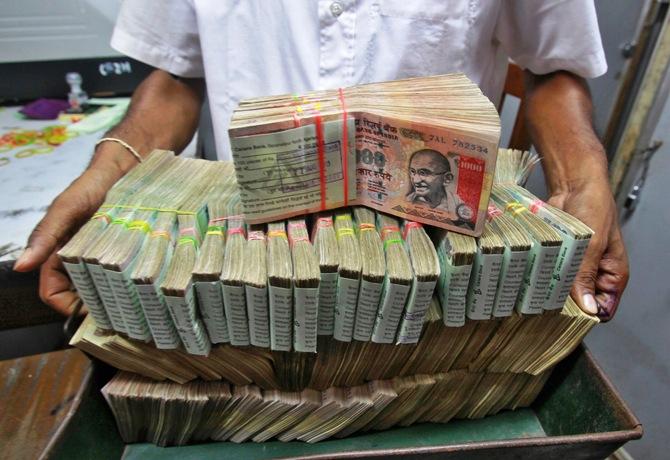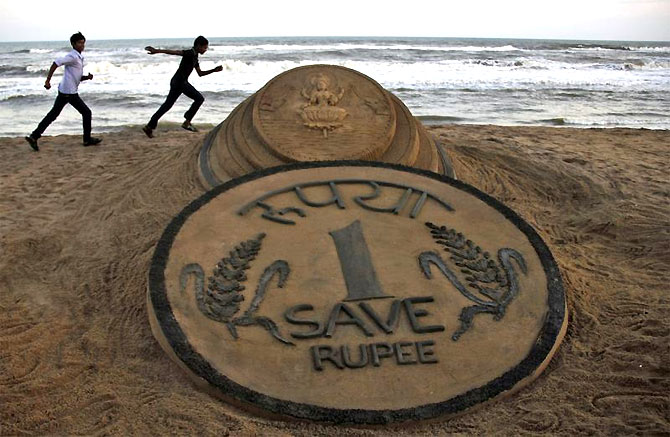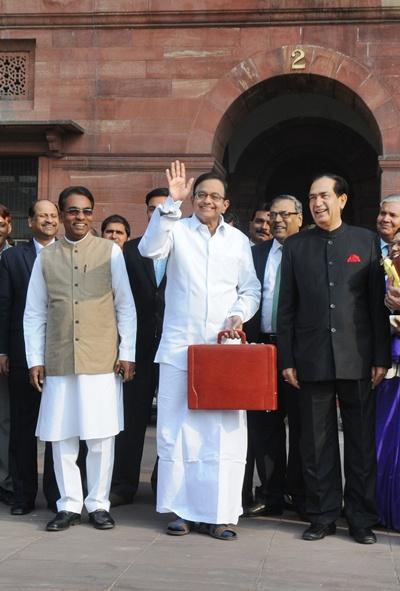Photographs: Reuters Abheek Barua
Even to the more jaded India hands inured to the tricks of the country’s fiscal trade, an overwhelming element of jugaad – that desperate bid to somehow put the decades-old family Ambassador together for that one final ride – is apparent.
I am reasonably certain that I am not the sole commentator who finds it difficult to pass judgement on the interim Budget.
The fact that Finance Minister P Chidambaram produced a fiscal deficit estimate of 4.6 per cent of gross domestic product (GDP) for 2013-14, a tad below his much-touted “red line” of 4.8 per cent, certainly deserves applause.
For one thing, it reveals the finance minister’s ability to appreciate the fact that the external world’s perception of our economy and macroeconomic policy is critical at this stage.
India is (perhaps somewhat unfairly) in a basket of the “more vulnerable” emerging markets, like Turkey and South Africa, which have twin deficits both in their domestic budgets and in their external accounts.
Global sentiment is turning against emerging markets as a whole and any misstep on the fiscal front could cost us dearly in the future in terms of external capital flows that our current account gap feeds on.
..
Fiscal deficit: The devil is in the detail
Image: Finance Minister P Chidambaram.Photographs: Courtesy, PIB
In producing a fiscal deficit estimate of 4.6 per cent for 2013-14 and 4.1 per cent for 2014-15, Mr Chidambaram has not only sent the right signal to the outside world but also paved a way that his successor would find it difficult to stray from.
Thus, the casual Budget watcher is likely to walk away with the impression that India is an economy on the mend. Its current account deficit has deflated somewhat dramatically and fiscal consolidation also seems to be on track. So far, so good!
However, there are reasons to feel a little less smug when it comes to assessing how exactly the deficit number has been reached.
Even to the more jaded India hands inured to the tricks of the country’s fiscal trade, an overwhelming element of “jugaad” – that desperate bid to somehow put the decades-old family Ambassador together for that one final ride – is apparent.
...
Fiscal deficit: The devil is in the detail
Photographs: Reuters
Thus, subsidy payments for fuel and fertilisers have yet again been pushed to the next fiscal year (a whopping Rs 35,000 crore for the oil bill alone), playing havoc with the cash flows of companies in these sectors and perpetuating an almost karmic cycle of under-budgeting and deferral.
Instead, the axe has fallen on the more “productive” Plan expenditures that contribute to both investment and capacity creation. Revised Plan expenditure is lower than the budgeted amount by about Rs 80,000 crore (Rs 800 billion), or 0.7 per cent of GDP.
Given the economic slowdown, revenues have predictably taken a hit. Overall tax growth numbers are at 13 per cent for 2013-14, going by the revised estimates, instead of the 19.4 per cent that was budgeted for. This too seems a trifle aggressive and, given the current rate, assumes a massive surge in tax collections in the last quarter.
Non-tax revenues – spectrum sales and special dividends from public sector companies – have come to the rescue. These are higher than the budgeted amount by a good Rs 20,000 crore (Rs 200 billlion).
...
Fiscal deficit: The devil is in the detail
Photographs: Reuters
The obvious caveat is that one-off “extraordinaries” cannot form the backbone of a long-term fiscal plan. The tenuousness of the government’s fiscal deficit estimates is perhaps highlighted by the following figures. The deficit for the whole year is estimated at 4.6 per cent of GDP, or Rs 5,24,539 crore (Rs 5.24 trillion).
If we look at the first nine months, the deficit already stands at Rs 5,16,390 crore (Rs 5.16 trillion). This leaves the government with just Rs 8,149 crore (Rs 81.49 billion) to run as additional deficit in the last quarter of 2013-14 as against Rs 85,191 crore in 2012-13.
In December alone, which saw advance tax payments, the deficit of the government stood at Rs 6,833 crore (Rs 68.33 billion). The bottom line is that if the right assumptions are used, the fiscal deficit is likely to be higher both in absolute terms and as a percentage of GDP.
But it might not be worth one’s while to get too fixated on the devil that lies in the detail. For one thing, this is just an interim Budget with a limited shelf life. Hopefully, the actual Budget for the year that the next government will present will be both more transparent on this fiscal year’s estimates and more realistic about the projections for the next year.
...
Fiscal deficit: The devil is in the detail
Photographs: Courtesy, PIB
Besides, I would not like to be too critical of Mr Chidambaram despite the occasional artifice or exaggeration. I believe that his obsession with fiscal consolidation has brought us back from the brink of economic catastrophe.
The fact that this involved the odd sleight of hand should evoke some empathy for the myriad constraints he faced in trying to fix the fisc — from the inability to raise fuel prices to seeing the implementation of the new tax codes being indefinitely delayed.
This should underscore the need to develop a political consensus on these issues and forge a credible fiscal strategy. Otherwise, it might not be very long before the whole world starts to see through the smoke and mirrors.
Tailpiece: Should the finance minister really be taking all the credit for a fall in the current account deficit? Isn’t that largely outside the domain of government policy?
Abheek Barua is Chief economist, HDFC Bank.







article